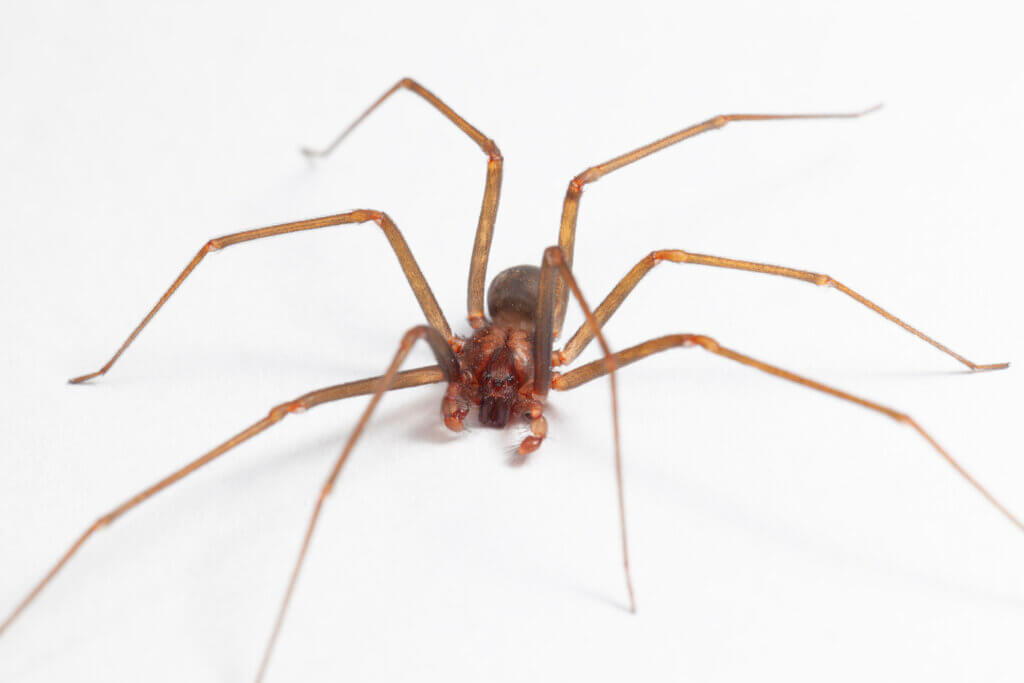What You Need to Know About the Brown Recluse Spider
As one of the two venomous spiders in the Kentucky/Ohio area, the brown recluse spider is widely feared and unfortunately, common to find in local homes and businesses. The more you know about this nasty spider, the better prepared you will be to deal with them. Here’s everything you need to know.
What do Brown Recluse Spiders Look Like

Brown recluse spiders are sometimes referred to as a ‘fiddleback’ or ‘violin’ spider due to the identifiable violin marking on their back. Though variable in size, adult brown recluse spiders with legs extended are about the size of a U.S. quarter. Coloration ranges from tan to dark brown, and the abdomen and legs are uniformly colored with no stripes, bands, or mottling. The legs are long and thin and lack conspicuous spines. Brown recluse spiders were given their name due to their reclusive nature and preference to retreat to dark and secluded areas especially during daylight hours. They will hunt at night in search for dead or alive insect prey. They eat small insects and other spiders. As a running spider (not a spider that uses webs to catch prey), the brown recluse chases down prey like a wolf. The purpose of their venom is to subdue their prey. They make webs for shelter and not for capturing insects.
Where Do Brown Recluse Spiders Hide

True to their name, they tend to stay away from people. Hiding in dark, secluded areas. But they don’t know that your boot is about to go on your foot. To them, it’s just a quiet dark place to hang out for a bit. Brown recluse spiders will live happily in attics and are resilient enough to survive the winter – even in unheated basements and garages. Your closet also seems like a good place to hide until you reach for your sweater. They are even known to hang out under the toilet seat. Turning on the light when you get up in the middle of the night to go to the bathroom will wake you up more than you want, but it will make a brown recluse spider scurry away instead of hiding under the seat or in the corner. Shaking out clothes, shoes, and even the blankets on your bed before using will encourage them to move along as well. Brown recluse spiders aren’t aggressive toward people. Most times, the bites happen when someone encounters them by mistake, but it doesn’t make the bite any less dangerous.
What Could Happen if I Get Bitten by a Brown Recluse Spider

Brown recluse spider bite symptoms include redness, itchiness, pain, and wounds. Mild to intense pain and itching for 2 to 8 hours following the bite will often happen. An open sore (ulcer) with a breakdown of tissue (necrosis) that develops a week or more following the bite. If the wound is untreated, it could lead to bruising, a blister, an open sore, and scarring. You should get right to a doctor if you think you’ve been bitten by a brown recluse spider. Don’t call your pest control provider. They will refer you to a doctor – and if they don’t, find another pest control provider because that one’s not for you. The only one that should be diagnosing a brown recluse spider bite is a medical professional. They will then proceed with brown recluse spider treatment which may include medication. Leaving a bite alone to heal on its one is not recommended. The longer you let it go the more scarring and more serious it can be.
What Does a Brown Recluse Spider Bite Feel Like
The reason why some people let a bite from a brown recluse spider go is because they don’t feel it initially. For everything that can happen from it, you’d think it would feel like a bee sting, but it doesn’t. The burning, pain, itching, or redness at the site of a bite is usually delayed and may develop within several hours or even days after. No wonder some let the bite go – they may not know it happened. At the first onset of the burning pain, get to a doctor to start treatment. Don’t hesitate. Wouldn’t you rather be a little embarrassed that you thought a mosquito bite was a brown recluse spider bite than have a silver-dollar-sized scar from an actual bite you let go?
The brown recluse spider is a potentially dangerous pest – and not to be trifled with. And its nature to hide makes it difficult to deal with unless you’ve got a trained eye. It may be time to bring in a professional when it comes to this spider. Best not to leave this one to chance or DIY brown recluse spider methods that don’t work. For almost all pests, all DIY methods do are force the pest into another part of the house or deeper into hiding. They certainly don’t kill the brown recluse spider or any other pest. The last thing you want is brown recluse spiders working harder to hide in your home or business.